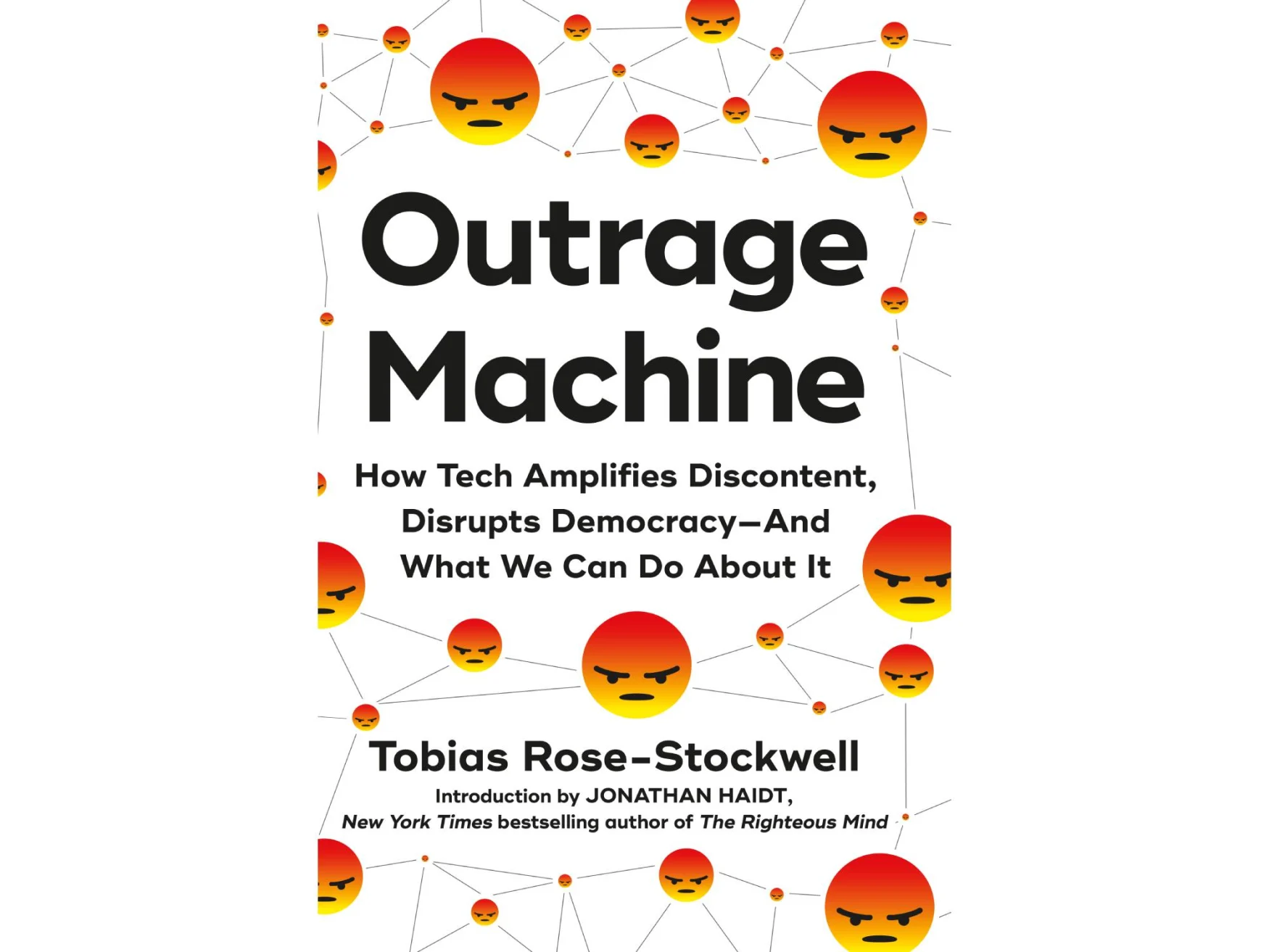If reality television has taught us anything, it’s there’s not much people won’t do if offered enough money and attention. Sometimes, even just the latter. Unfortunately for the future prospects of our civilization, modern social media has focused upon those same character foibles and optimized them at a global scale, sacrifices at the altar of audience growth and engagement. In Outrage Machine, writer and technologist Tobias Rose-Stockwell, walks readers through the inner workings of these modern technologies, illustrating how they’re designed to capture and keep our attention, regardless of what they have to do in order to do it. In the excerpt below, Rose-Stockwell examines the human cost of feeding the content machine through a discussion on YouTube personality Nikocado Avocado’s rise to internet stardom.

Legacy Lit
Excerpted from OUTRAGE MACHINE: How Tech Amplifies Discontent, Disrupts Democracy—And What We Can Do About It by Tobias Rose-Stockwell. Copyright © 2023 by Tobias Rose-Stockwell. Reprinted with permission of Legacy Lit. All rights reserved.
This Game Is Not Just a Game
Social media can seem like a game. When we open our apps and craft a post, the way we look to score points in the form of likes and followers distinctly resembles a strange new playful competition. But while it feels like a game, it is unlike any other game we might play in our spare time.
The academic C. Thi Nguyen has explained how games are different: “Actions in games are screened off, in important ways, from ordinary life. When we are playing basketball, and you block my pass, I do not take this to be a sign of your long-term hostility towards me. When we are playing at having an insult contest, we don’t take each other’s speech to be indicative of our actual attitudes or beliefs about the world.” Games happen in what the Dutch historian Johan Huizinga famously called “the magic circle”— where the players take on alternate roles, and our actions take on alternate meanings.
With social media we never exit the game. Our phones are always with us. We don’t extricate ourselves from the mechanics. And since the goal of the game designers of social media is to keep us there as long as possible, it’s an active competition with real life. With a constant type of habituated attention being pulled into the metrics, we never leave these digital spaces. In doing so, social media has colonized our world with its game mechanics.
Metrics are Money
While we are paid in the small rushes of dopamine that come from accumulating abstract numbers, metrics also translate into hard cash. Acquiring these metrics don’t just provide us with hits of emotional validation. They are transferable into economic value that is quantifiable and very real.
It’s no secret that the ability to consistently capture attention is an asset that brands will pay for. A follower is a tangible, monetizable asset worth money. If you’re trying to purchase followers, Twitter will charge you between $2 and $4 to acquire a new one using their promoted accounts feature.
If you have a significant enough following, brands will pay you to post sponsored items on their behalf. Depending on the size of your following in Instagram, for instance, these payouts can range from $75 per post (to an account with two thousand followers), up to hundreds of thousands of dollars per post (for accounts with hundreds of thousands of followers).
Between 2017 and 2021, the average cost for reaching a thousand Twitter users (the metric advertisers use is CPM, or cost per mille) was between $5 and $7. It costs that much to get a thousand eyeballs on your post. Any strategies that increase how much your content is shared also have a financial value.
Let’s now bring this economic incentive back to Billy Brady’s accounting of the engagement value of moral outrage. He found that adding a single moral or emotional word to a post on Twitter increased the viral spread of that content by 17 percent per word. All of our posts to social media exist in a marketplace for attention — they vie for the top of our followers’ feeds. Our posts are always competing against other people’s posts. If outraged posts have an advantage in this competition, they are literally worth more money.
For a brand or an individual, if you want to increase the value of a post, then including moral outrage, or linking to a larger movement that signals its moral conviction, might increase the reach of that content by at least that much. Moreover, it might actually improve the perception and brand affinity by appealing to the moral foundations of the brand’s consumers and employees, increasing sales and burnishing their reputation. This can be an inherently polarizing strategy, as a company that picks a cause to support, whose audience is morally diverse, might then alienate a sizable percentage of their customer base who disagree with that cause. But these economics can also make sense — if a company knows enough about its consumers’ and employees’ moral affiliations — it can make sure to pick a cause-sector that’s in line with its customers.
Since moral content is a reliable tool for capturing attention, it can also be used for psychographic profiling for future marketing opportunities. Many major brands do this with tremendous success — creating viral campaigns that utilize moral righteousness and outrage to gain traction and attention among core consumers who have a similar moral disposition. These campaigns also often get a secondary boost due to the proliferation of pile- ons and think pieces discussing these ad spots. Brands that moralize their products often succeed in the attention marketplace.
This basic economic incentive can help to explain how and why so many brands have begun to link themselves with online cause-related issues. While it may make strong moral sense to those decision-makers, it can make clear economic sense to the company as a whole as well. Social media provides measurable financial incentives for companies to include moral language in their quest to burnish their brands and perceptions.
But as nefarious as this sounds, moralization of content is not always the result of callous manipulation and greed. Social metrics do something else that influences our behavior in pernicious ways.
Audience Capture
In the latter days of 2016, I wrote an article about how social media was diminishing our capacity for empathy. In the wake of that year’s presidential election, the article went hugely viral, and was shared with several million people. At the time I was working on other projects full time. When the article took off, I shifted my focus away from the consulting work I had been doing for years, and began focusing instead on writing full time. One of the by-products of that tremendous signal from this new audience is the book you’re reading right now.
A sizable new audience of strangers had given me a clear message: This was important. Do more of it. When many people we care about tell us what we should be doing, we listen.
This is the result of “audience capture”: how we influence, and are influenced by those who observe us. We don’t just capture an audience — we are also captured by their feedback. This is often a wonderful thing, provoking us to produce more useful and interesting works. As creators, the signal from our audience is a huge part of why we do what we do.
But it also has a dark side. The writer Gurwinder Boghal has explained the phenomena of audience capture for influencers illustrating the story of a young YouTuber named Nicholas Perry. In 2016, Perry began a You- Tube channel as a skinny vegan violinist. After a year of getting little traction online, he abandoned veganism, citing health concerns, and shifted to uploading mukbang (eating show) videos of him trying different foods for his followers. These followers began demanding more and more extreme feats of food consumption. Before long, in an attempt to appease his increasingly demanding audience, he was posting videos of himself eating whole fast-food menus in a single sitting.
He found a large audience with this new format. In terms of metrics, this new format was overwhelmingly successful. After several years of following his audience’s continued requests, he amassed millions of followers, and over a billion total views. But in the process, his online identity and physical character changed dramatically as well. Nicholas Perry became the personality Nikocado — an obese parody of himself, ballooning to more than four hundred pounds, voraciously consuming anything his audience asked him to eat. Following his audience’s desires caused him to pursue increasingly extreme feats at the expense of his mental and physical health.

Legacy Lit
Nicholas Perry, left, and Nikocado, right, after several years of building a following on YouTube. Source: Nikocado Avocado YouTube Channel.
Boghal summarizes this cross-directional influence.
When influencers are analyzing audience feedback, they often find that their more outlandish behavior receives the most attention and approval, which leads them to recalibrate their personalities according to far more extreme social cues than those they’d receive in real life. In doing this they exaggerate the more idiosyncratic facets of their personalities, becoming crude caricatures of themselves.
This need not only apply to influencers. We are signal-processing machines. We respond to the types of positive signals we receive from those who observe us. Our audiences online reflect back to us what their opinion of our behavior is, and we adapt to fit it. The metrics (likes, followers, shares, and comments) available to us now on social media allow for us to measure that feedback far more precisely than we previously could, leading to us internalizing what is “good” behavior.
As we find ourselves more and more inside of these online spaces, this influence becomes more pronounced. As Boghal notes, “We are all gaining online audiences.” Anytime we post to our followers, we are entering into a process of exchange with our viewers — one that is beholden to the same extreme engagement problems found everywhere else on social media.
All products recommended by Engadget are selected by our editorial team, independent of our parent company. Some of our stories include affiliate links. If you buy something through one of these links, we may earn an affiliate commission. All prices are correct at the time of publishing.
Trending Products

Cooler Master MasterBox Q300L Micro-ATX Tower with Magnetic Design Dust Filter, Transparent Acrylic Side Panel…

ASUS TUF Gaming GT301 ZAKU II Edition ATX mid-Tower Compact case with Tempered Glass Side Panel, Honeycomb Front Panel…

ASUS TUF Gaming GT501 Mid-Tower Computer Case for up to EATX Motherboards with USB 3.0 Front Panel Cases GT501/GRY/WITH…

be quiet! Pure Base 500DX Black, Mid Tower ATX case, ARGB, 3 pre-installed Pure Wings 2, BGW37, tempered glass window

ASUS ROG Strix Helios GX601 White Edition RGB Mid-Tower Computer Case for ATX/EATX Motherboards with tempered glass…










